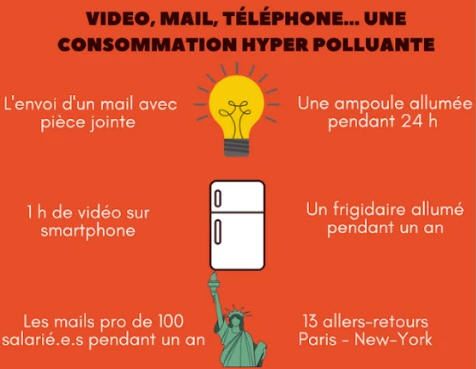The theme of the environmental cost of streaming is too important to let fake news spread out. The numbers are high enough to make it unnecessary to exaggerate them, at the risk of providing arguments to sceptics.
Here are some quotes put into perspective.
From Les Echos : https://www.lesechos.fr/tech-medias/medias/le-cout-ecologique-faramineux-du-streaming-video-1038436
“A concrete example: one hour of video on a smartphone is equivalent to the consumption of a refrigerator on for one year.”
Information contained in a computer graphics published by Novethic and corrected since:

The unravelling is to be read in the answer written by Frédéric Bordage, from the GreenIT Collective (in French) : https://www.greenit.fr/2019/07/22/%ef%bb%bfvideo-en-ligne-quels-impacts-environnementaux/
The decoding :
- The average consumption of a refrigerator is 150KWh, or 0.054kWh of primary energy per hour
- One hour of online video viewing corresponds to a consumption of 0.5 to 4.5 kWh of primary energy depending on the terminal and connection mode. On a smartphone, we are therefore closer to 0.5KW consumed over an hour.
The result is….
One hour of online video viewing on a smartphone is therefore equivalent to 11 hours of refrigerator consumption (if we do not count the impact of its manufacture)!
“On the Internet user side, the report recommends limiting his/her consumption to one hour of video streaming per day, by watching low definition content. This can be added to Ademe’s suggestion: always prefer downloading to streaming..”
The decoding :
We cannot say that downloading should be preferred to streaming. This is only true in the case of music when the same title is played several times. With VOD, the best quality available is downloaded, while in adaptive streaming the data is downloaded as the playback progresses, at a data rate that varies according to the available bandwidth. If downloaded content is not played back in full or if the network connection is poor, streaming will be more economical in terms of transferred data. Downloading is therefore preferable to streaming only for content that will be viewed in full and reviewed several times.
From theepochtimes.com
https://fr.theepochtimes.com/lempreinte-ecologique-croissante-dinternet-22490.html
“Netflix (VoD) broadcasts more than a billion hours of video per month. This would imply that Netflix would use more than 9 billion kWh per month, which is comparable to the energy used by about 1 billion US households (over the same period).”
The decoding :
- One hour of online video viewing corresponds to a consumption of 0.5 to 4.5 kWh of primary energy depending on the terminal and connection mode (not 9KWh!).
- An American household consumes about 970KWh/month (not 9KWh!)
- 9MdsKWh corresponds to the monthly consumption of 9.3M American households (not 1 billion!)
The result is…
1 billion hours of video (which Netflix broadcasts each month) corresponds to the monthly electricity consumption of 515,000 to 4.6 million American households.
“Watching a 3GB video requires as much energy as 1000 low-energy light bulbs on for an hour.”
“The energy you use for one hour of streaming video is comparable to using a hair dryer for 30 minutes a day for one year, or operating an air conditioner for 16 hours.”
The decoding :
- 1 hour of video = 3GB
- One hour of online video viewing corresponds to a consumption of 0.5 to 4.5 kWh of primary energy depending on the terminal and connection mode
- The average power of a hair dryer is 1800W
- The average power of an air conditioner is 3500W
- 1000 15W bulbs turned on for one hour = 15KWh
- The use of a hair dryer for 30 minutes a day for one year represents a consumption of 328.5KWh
- The 16-hour operation of an air conditioner represents a consumption of 56KWh
The result is…
1 hour of online video = 1000 15W bulbs turned on for 2' to 18'.1 hour of online video = between 17' and 1h30 using a hair dryer1 hour of online video = between 9' and 1h17 of using an air conditioner
